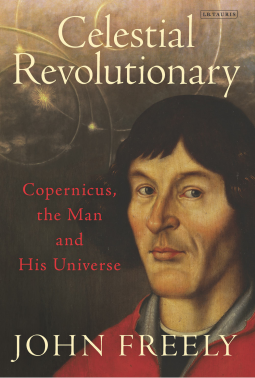
Celestial Revolutionary
Copernicus, the Man and His Universe
by John Freely
This title was previously available on NetGalley and is now archived.
Send NetGalley books directly to your Kindle or Kindle app
1
To read on a Kindle or Kindle app, please add kindle@netgalley.com as an approved email address to receive files in your Amazon account. Click here for step-by-step instructions.
2
Also find your Kindle email address within your Amazon account, and enter it here.
Pub Date 30 May 2014 | Archive Date 24 Jul 2014
Description
In the spring of 1500, at the apex of the Renaissance, a papal secretary to the Borgia Pope, Alexander VI, wrote that "All the world is in Rome." Though no one knew it at the time, this included a young scholar by the name of Nicolaus Copernicus who would one day change the world.
One of the greatest polymaths of his or any age - linguist, lawyer, doctor, diplomat, politician, mathematician, scientist, astronomer, artist, cleric - Copernicus gave the world arguably the most important scientific discovery of the modern era: that earth and the planets revolve around the sun and that the earth rotates on its axis once every 24 hours. His heliocentric theory and the discoveries that would follow ushered in the age of modern astronomy, often called the Copernican Age, and change the way we look at the universe forever. Here, for the first time, is a biography of Copernicus that not only describes his theories but the life of the man himself and the epic, thrilling times in which he lived
Advance Praise
Praise for John Freely
'Whenever I'm asked to recommend a book about Turkey, I reply, 'Anything by John Freely''
Stephen Kinzer, former New York Times correspondent
'Freely abounds in colourful details…'
Philip Mansel, Independent
'[The Western Shores of Turkey is an] enchanting guide…a work of genuine scholarship, lightly worn and charmingly conveyed. I fell in love with the book and stayed enamoured until the final page.'
Paul Bailey, The Sunday Times
'...a man effortlessly able to convey in depth the meaning of what he sees.'
Marlena Frick, Scotsman
'...a classic. The best travel guide to Istanbul'
The Times
'Freely reveals a superb eye for the telling detail.'
Independent
Marketing Plan
No Marketing Info Available
No Marketing Info Available
Available Editions
| EDITION | Hardcover |
| ISBN | 9781780763507 |
| PRICE | £18.99 (GBP) |
Average rating from 9 members
Readers who liked this book also liked:
Jennie Batchelor, Julia Quinn, Natalie Jenner, Charlie Lovett, Talulah Riley, Janet Todd et al
Essays & Collections, Novellas & Short Stories, Women's Fiction







